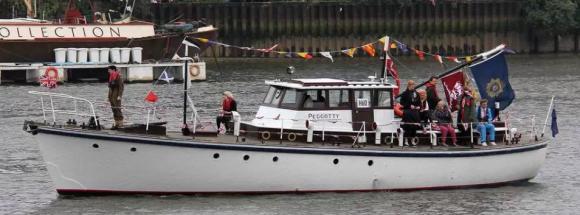
Photo: Sun UK
The UK Marine Accident Investigation Branch (MAIB) recently released a report on a collision between the 50 ft wooden WWII-era training boat Peggotty and the 32,000 GT cargo ferry Petunia Seaways on the UK’s Humber estuary. The report concluded that the use of an iPad as a primary means of navigation aboard Peggotty was a key factor behind the accident. In the collision with the much larger vessel, the Peggotty sank, while the captain of the cargo ferry was not initially aware that a collision had taken place.
At first glance it would be easy to say simply “another inexperienced mariner relying more on electronics than seamanship.” What makes this story interesting is that the statement is only half true. No doubt, too much reliance was placed on electronics, but the mariners involved were all professionals. The owner and skipper of the Peggotty, David Carlin, holds an unlimited master’s license and works as a pilot on the Humber.
Maritime Executive reports that, Carlin was selling the historic WWII training vessel, and in the early hours of May 19, 2016, took a buyer’s representative for a short trip on the Humber estuary. The representative was also well qualified, having served as an engineer in the Royal Navy and as the skipper of a safety boat. The owner’s representative was the owner of the notorious iPad.
As is the case with most calamities, a series of mistakes and failures led to the collision. To get under a bridge, the two men lowered the Peggotty’s radar mast, which disabled the radar. The boat did not have a compass, and the chart plotter aboard did not have charts for the area. The owner’s representative offered his iPad to be used to navigate, which apparently had a navigation app installed. It was a foggy morning, at around 4 AM. Visibility was reported to be somewhere from zero to 300 feet. With no compass, chartplotter or radar and relying on an iPad for navigation, they set off.
At about the same time the DFDS Seaways cargo ferry, Petunia Seaways, left the dock bound for Gothenburg, Sweden. The captain of the Petunia Seaways did not turn on the ship’s automatic fog signal.
Onboard the Peggotty, Carlin attempted to communicate with Vessel Traffic Services (VTS) on a handheld VHF radio but failed. VTS replied that the signal was too weak to be understood. In the meantime, the Peggotty was proceeding directly into the shipping channel. The iPad navigation app had stopped working as it lost the wifi connection.
On the bridge of the Petunia Seaways, the captain was picking up an intermittent radar image in the channel. He blew the ferry’s horn and altered course slightly to port to give the unidentified object additional room. Carlin heard the ship’s horn but in the fog could not tell which direction it was coming from. He again called VTS on his handheld radio but again, did not get through. A few moments later, he saw the bow of the cargo ferry loom through the fog. The ferry struck the stern of the Peggotty, spinning her around.
Fortunately, neither Carlin nor the owner’s representative on the Peggotty were injured. The WWII-era training boat, however, was mortally wounded. Peggotty would sink in about a half an hour. A pilot boat rescued the two men off the deck of the sinking boat.
Both Carlin and the 60-year-old Danish captain of the ferry were fined £3,000 by Hull magistrates for breaching maritime laws. Carlin, a pilot with Associated British Ports, has been suspended from his job.
Too often, complacency can be just as dangerous as inexperience. While it might be easy to blame the use of an iPad, that may miss the larger point.
There were many opportunities to avoid the loss of the Peggotty. If the men had taken the time to raise the radar mast and be sure that the radar was functional, the collision might have been avoided. The same might be said if the chartplotter had the proper electronic charts, or if there was a backup GPS aboard with paper charts. It is even possible that new batteries in the handheld radio might have made allowed effective communication with the harbor master, again, at least potentially, avoiding the collision. Alternatively, not leaving the dock until visibility improved may have been the best choice of all.
It should go without saying that if the vessel is not ready for sea, or in this case, to venture out into the estuary, the lines should stay fast to the dock. To paraphrase that old salt Will Shakespeare, too often the fault lies not in our stars (or our iPads or chartplotters) but ourselves.
Thanks to Alaric Bond, Roberta Weisbrod and Ralph Duncan for contributing to this post.

Technology moves on. first we had DACs, then GACs and now iPACs.
The whole report reads as a jungle of complacency.
Another sad report just up on MAIB is the case of the strong swimmer who made a clean but unplanned exit from a scallop dredger into 10C water, was incapacitated in 4 minutes, full of water in 5 minutes, dead in 10. No PFD, of course, because fishermen are too brave to remember that the suffering only begins when the dying is done.
Writing these “fisherman drowns while not wearing PFD” reports must be dismally boring by this point, and incredibly aggravating as would-be beneficiaries make up elaborate excuses for being susceptible to brainless peer pressure.